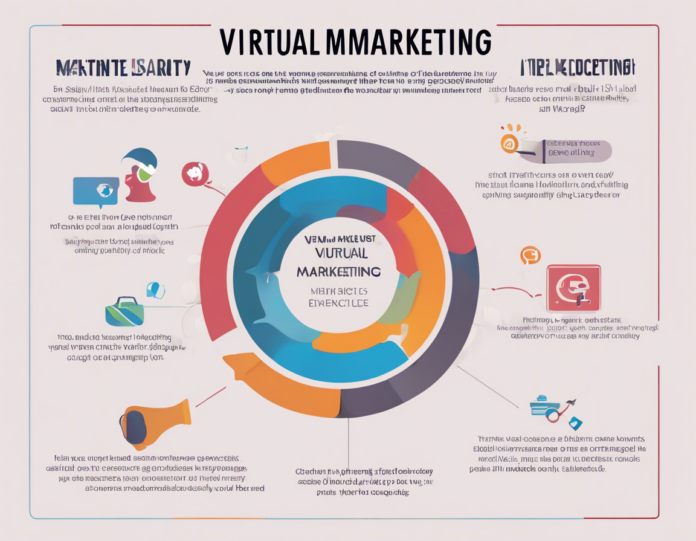In today’s rapidly evolving digital landscape, the concept of virtual marketing has become increasingly prominent. Virtual marketing refers to the strategies and techniques used by businesses to promote their products, services, or brand in the online realm. This form of marketing leverages various digital channels, such as websites, social media platforms, email, search engines, and online advertising, to reach and engage with target audiences.
With the rise of the internet and the proliferation of digital devices, virtual marketing has become essential for businesses looking to connect with consumers in the digital space. By utilizing innovative digital marketing tactics, businesses can enhance their online presence, build brand awareness, drive website traffic, generate leads, and increase sales.
The Evolution of Virtual Marketing
Virtual marketing has undergone a significant evolution over the years, adapting to the changing digital landscape and consumer behavior. In the past, traditional marketing tactics such as print ads, TV commercials, and direct mail were the primary means of reaching audiences. However, with the advent of the internet and the explosion of digital technologies, businesses have had to shift their focus to virtual marketing to stay competitive in the digital age.
Key Components of Virtual Marketing
1. Search Engine Optimization (SEO)
SEO is a crucial component of virtual marketing that focuses on optimizing a website to improve its visibility in search engine results. By incorporating relevant keywords, creating high-quality content, and building backlinks, businesses can enhance their organic search rankings and attract more traffic to their site.
2. Content Marketing
Content marketing involves creating and sharing valuable content, such as blog posts, videos, infographics, and ebooks, to attract and engage target audiences. By providing relevant and informative content, businesses can establish themselves as industry experts and build trust with their audience.
3. Social Media Marketing
Social media marketing revolves around leveraging social media platforms, such as Facebook, Twitter, Instagram, and LinkedIn, to connect with customers, build relationships, and promote products or services. By engaging with followers, sharing relevant content, and running targeted ads, businesses can expand their reach and drive engagement on social media.
4. Email Marketing
Email marketing entails sending commercial messages to a group of people via email. This form of marketing is highly effective for nurturing leads, promoting products, and driving conversions. By personalizing emails, segmenting email lists, and analyzing email performance, businesses can optimize their email marketing campaigns for better results.
5. Pay-Per-Click (PPC) Advertising
PPC advertising involves bidding on keywords to display ads on search engines or websites. Businesses only pay when a user clicks on their ad, making it a cost-effective way to drive targeted traffic to their site. By conducting keyword research, creating compelling ad copy, and monitoring campaign performance, businesses can maximize the ROI of their PPC campaigns.
Advantages of Virtual Marketing
1. Global Reach
Virtual marketing allows businesses to reach a global audience, breaking down geographical barriers and expanding their market reach beyond traditional boundaries.
2. Cost-Effective
Compared to traditional marketing methods, virtual marketing is often more cost-effective, as businesses can reach a larger audience at a lower cost through digital channels.
3. Measurable Results
With virtual marketing, businesses can track and measure the performance of their campaigns in real-time, allowing them to make data-driven decisions and optimize their marketing strategies for better results.
4. Targeted Advertising
Virtual marketing enables businesses to target specific demographics, interests, and behaviors, ensuring that their marketing messages reach the right audience at the right time.
5. Increased Engagement
Through social media, email marketing, and content marketing, businesses can engage with customers in meaningful ways, fostering relationships and driving brand loyalty.
Challenges of Virtual Marketing
While virtual marketing offers numerous benefits, it also presents challenges that businesses must navigate to succeed in the digital landscape.
1. Digital Saturation
The proliferation of digital channels and content has led to increased competition and noise, making it challenging for businesses to cut through the clutter and capture the attention of their target audience.
2. Changing Algorithms
Digital platforms frequently update their algorithms, impacting the visibility and reach of businesses’ marketing efforts. Staying abreast of these changes and adjusting strategies accordingly is essential for success.
3. Data Privacy Concerns
With the rise of data breaches and privacy scandals, consumers are becoming more cautious about sharing their personal information online. Businesses must prioritize data security and transparency to build trust with their audience.
4. Ad Blocking
The prevalence of ad-blocking software poses a challenge for businesses relying on online advertising to reach customers. To overcome this obstacle, businesses must create non-intrusive, valuable content that resonates with users.
5. Content Overload
Consumers are inundated with massive amounts of content daily, leading to information overload and shorter attention spans. To break through the noise, businesses must create compelling, relevant content that captivates their audience’s interest.
Virtual Marketing Best Practices
To maximize the impact of virtual marketing efforts, businesses should follow these best practices:
– Define clear objectives: Set specific, measurable goals for your virtual marketing campaigns to track performance and ROI effectively.
– Understand your target audience: Conduct market research to identify your target audience’s demographics, interests, and online behaviors to tailor your marketing messages effectively.
– Create high-quality content: Develop engaging, valuable content that resonates with your audience and positions your brand as a thought leader in your industry.
– Utilize multiple digital channels: Leverage a mix of SEO, social media, email marketing, and online advertising to reach and engage with customers across various touchpoints.
– Monitor and analyze performance: Track key performance indicators (KPIs) such as website traffic, conversion rates, and engagement metrics to assess the effectiveness of your virtual marketing campaigns.
FAQs about Virtual Marketing
1. What is the difference between virtual marketing and traditional marketing?
While traditional marketing focuses on offline channels like print, TV, and radio, virtual marketing utilizes online platforms such as websites, social media, email, and search engines to reach and engage with audiences in the digital space.
2. How can businesses measure the success of their virtual marketing campaigns?
Businesses can track the performance of their virtual marketing campaigns by monitoring key metrics such as website traffic, conversion rates, click-through rates, engagement metrics, and ROI.
3. What are some common virtual marketing mistakes to avoid?
Common virtual marketing mistakes include neglecting SEO best practices, ignoring mobile optimization, failing to target the right audience, neglecting social media engagement, and overlooking the importance of analytics and data tracking.
4. How can businesses overcome digital saturation and stand out in a crowded online landscape?
To stand out in a crowded online landscape, businesses should focus on creating unique, high-quality content, engaging with their audience on social media, leveraging influencer partnerships, and utilizing targeted advertising to reach specific customer segments.
5. What trends are shaping the future of virtual marketing?
Emerging trends in virtual marketing include the rise of artificial intelligence and machine learning, the increasing importance of personalization and customer experience, the growth of video content and live streaming, and the continuous evolution of social media platforms and algorithms.
In conclusion, virtual marketing has become a cornerstone of modern marketing strategies, enabling businesses to connect with audiences, drive engagement, and achieve their marketing goals in the digital age. By leveraging the power of digital channels, businesses can reach global audiences, optimize their marketing efforts, and stay ahead of the competition in an ever-evolving digital landscape.


